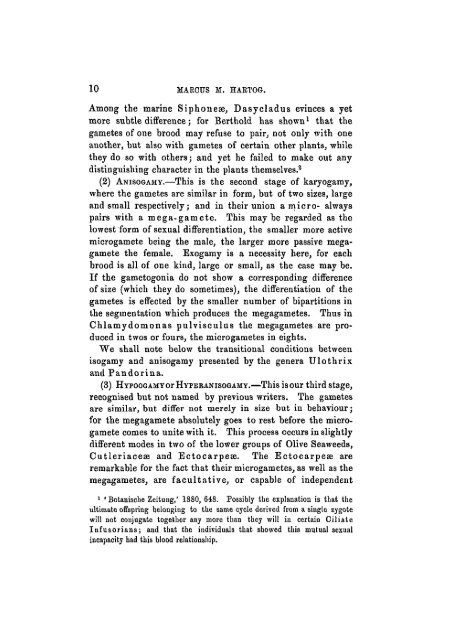Some Problems of Reproduction: a Comparative Study of ...
Some Problems of Reproduction: a Comparative Study of ...
Some Problems of Reproduction: a Comparative Study of ...
Create successful ePaper yourself
Turn your PDF publications into a flip-book with our unique Google optimized e-Paper software.
10 MARCUS M. HARTOG.<br />
Among the marine Siphonese, Dasycladus evinces a yet<br />
more subtle difference; for Berthold has shown 1 that the<br />
gametes <strong>of</strong> one brood may refuse to pair, not only with one<br />
another, but also with gametes <strong>of</strong> certain other plants, while<br />
they do so with others; and yet he failed to make out any<br />
distinguishing character in the plants themselves. 3<br />
(2) ANISOGAMY.—This is the second stage <strong>of</strong> karyogamy,<br />
where the gametes are similar in form, but <strong>of</strong> two sizes, large<br />
and small respectively; and in their union a micro- always<br />
pairs with a mega-gamete. This maybe regarded as the<br />
lowest form <strong>of</strong> sexual differentiation, the smaller more active<br />
microgamete being the male, the larger more passive megagamete<br />
the female. Exogamy is a necessity here, for each<br />
brood is all <strong>of</strong> one kind, large or small, as the case may be.<br />
If the gametogonia do not show a corresponding difference<br />
<strong>of</strong> size (which they do sometimes), the differentiation <strong>of</strong> the<br />
gametes is effected by the smaller number <strong>of</strong> bipartitions in<br />
the segmentation which produces the megagametes. Thus in<br />
Chlamydomonas pulvisculus the megagametes are produced<br />
in twos or fours, the microgametes in eights.<br />
We shall note below the transitional conditions between<br />
isogamy and anisogamy presented by the genera Ulothrix<br />
and Pandorina.<br />
(3) EhrpooGAMYor HYPERANISOGAMY.—This is our third stage,<br />
recognised but not named by previous writers. The gametes<br />
are similar, but differ not merely in size but in behaviour;<br />
for the megagamete absolutely goes to rest before the microgamete<br />
comes to unite with it. This process occurs in slightly<br />
different modes in two <strong>of</strong> the lower groups <strong>of</strong> Olive Seaweeds,<br />
Cutleriacese and Ectocarpese. The Ectocarpese are<br />
remarkable for the fact that their microgametes, as well as the<br />
megagametes, are facultative, or capable <strong>of</strong> independent<br />
1 'Botanische Zeitung,' 1880, 648. Possibly the explanation is that the<br />
ultimate <strong>of</strong>fspring belonging to the same cycle derived from a single zygote<br />
will not conjugate together any more than they will in certain Ciliate<br />
Infusorians; and that the individuals that showed this mutual sexual<br />
incapacity had this blood relationship.

















